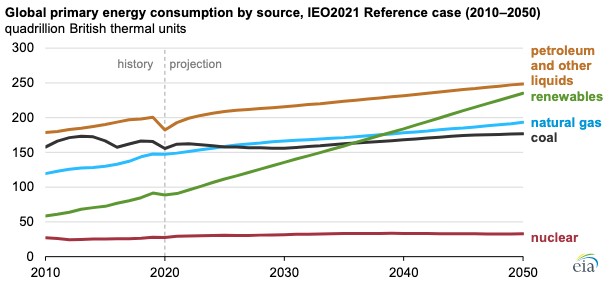
In today’s Electrek Green Energy Brief (EGEB):
- The US Energy Information Administration releases its International Energy Outlook 2021 report.
- Maine applies for a lease in federal waters for the US’s first offshore wind research site.
- UnderstandSolar is a free service that links you to top-rated solar installers in your region for personalized solar estimates. Tesla now offers price matching, so it’s important to shop for the best quotes. Click here to learn more and get your quotes. — *ad.
International Energy Outlook 2021
The US Energy Information Administration (EIA) this morning released its “International Energy Outlook 2021” report. What’s important to stress is that this report “assumes current laws and regulations.”

Note: Petroleum and other liquids includes biofuels.
So here’s what we can glean from this. If we don’t make changes, it’s not going to be good when it comes to reducing emissions and slowing global warming. Globally, we’ll continue to head in the wrong direction. The solution? DON’T stick with current laws and regulations.
Quoting the EIA, three key findings include:
- If current policy and technology trends continue, global energy consumption and energy-related carbon dioxide emissions will increase through 2050 as a result of population and economic growth.
The industrial and transportation sectors will largely drive the increase in energy consumption. Electric vehicle sales will grow through 2050, causing the internal combustion engine fleet to peak in 2023 for countries that are members of the Organization for Economic Cooperation and Development (OECD) and in 2038 globally. Despite this projected growth in electric vehicle sales, the continued growth in energy consumption will cause global energy-related carbon dioxide emissions to rise through 2050 according to our IEO2021 Reference case. - Renewables will be the primary source for new electricity generation, but natural gas, coal, and increasingly batteries will be used to help meet load and support grid reliability. Electricity generation will almost double in the developing non-OECD countries between 2020 and 2050. This generation will come largely from renewable resources, which are adopted because of falling technology costs and favorable laws and regulations. Although new generation will largely be powered by renewables, dispatchable generation sources — such as natural gas- and coal-fired generating technologies as well as batteries — will remain important, especially for grid reliability.
- Oil and natural gas production will continue to grow, mainly to support increasing energy consumption in developing Asian economies. Driven by increasing populations and fast-growing economies, consumption of liquid fuels will grow the most in non-OECD Asia, where total consumption nearly doubles by 2050 from 2020 levels in the Reference case. Because these countries will consume more liquid fuels than they produce in the Reference case, we project that non-OECD Asia will supplement local production with increased imports of crude oil and finished petroleum products. The increased imports will primarily be supported by increased production in the Middle East. In the Reference case, by 2050, non-OECD Asia will become the largest importer of natural gas, and Russia will become the largest net exporter of natural gas.
Floating offshore wind in Maine
The Maine Governor’s Energy Office submitted an application to the US Bureau of Ocean Energy Management (BOEM) to lease a 15.2-square-mile area nearly 30 miles offshore in the Gulf of Maine for the US’s first floating offshore wind research site in federal waters.
The state of Maine wants to deploy a small-scale research array of no more than 12 wind turbines on floating hulls designed at the University of Maine. The state would partner with the 11 megawatt floating offshore wind pilot project New England Aqua Ventus, Diamond Offshore Wind, and RWE Renewables.
The research site will be used to investigate how floating offshore wind interacts with Maine’s marine environment, fishing industry, and shipping and navigation routes.
In July, Maine banned new offshore wind projects in state waters, which will be used only for fishing and recreation. The state wants to locate offshore wind in federal waters in the Gulf of Maine.
Read more: Maine governor permanently bans offshore wind in state waters
Subscribe to Electrek on YouTube for exclusive videos and subscribe to the podcast.
Author: Michelle Lewis
Source: Electrek



